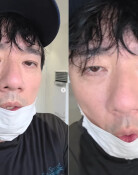Japanese Emperor Silent over Responsibility for War, only Making Good Impression on Memorial Service
Japanese Emperor Silent over Responsibility for War, only Making Good Impression on Memorial Service
Posted June. 28, 2005 06:03,
On June 27, Japanese Emperor Akihito and Empress Michiko visited the U.S. territorial island of Saipan, which was a colony of Japan during the Second World War and where approximately 75,000 soldiers and civilians died in the battle.
It was the first time that the Japanese Emperor visited a former colony for a memorial service after the end of the Second World War.
On the evening of the same day at Saipan, the Japanese Emperor and Empress engaged in a meeting with the members from the Japanese bereaved family committee and comrade society.
On June 28, the second day of their visit to Saipan, Emperor Akihito and Empress Michiko will see the Monument of the War Dead in the Mid-Pacific erected by the Japanese government and the cliff from which Japanese soldiers and civilians committed suicide and pay tributes to the dead.
In addition, they will pay their floral tributes to the Mariana Memorial, on which the names of the 933 dead local residents are carved, and the Memorial for the Second World War dedicated to the U.S. troops.
Regarding the matter, local islanders expect that Emperor Akihito and Empress Michikos floral tributes to the memorial will heal the scars of the two sides.
With an increasing number of Japanese tourists and trading volume with Japan, the residents on Saipan show a response that they dont necessarily have to raise the pain of 60 years ago as a past history.
However, the Korean Peace Memorial dedicated to the Korean victims, who suffered forced labor or died in battle in Saipan, was excluded from the Emperor and Empress visit list, which reflected that the visit by the emperor and empress was just an event for Japan.
The Korean Peace Memorial is five minutes away on foot from the monument for the war dead erected by the Japanese government.
As shown in the above schedule, the Emperors memorial pilgrimage this time takes a form of only cherishing the memory of the war dead, while keeping silence over the the Japanese royal familys responsibility for war (especially, Emperor Showa)
After the end of the Second World War, the Japanese Emperor was not allowed to visit a hard-fought field abroad for the purpose of paying tributes.
However, Emperor Akihito, who succeeded to the throne in 1989, has paid tributes to the war dead by visiting hard-fought fields, including Io Island, and Okinawa, since he expressed regret for the past history in China in 1992.
After all, the Emperors memorial pilgrimage, which serves to promote the expansion of influence on the past base by leading Japanese economic power, while remaining silent over his responsibility, neither pacifies neighboring countries nor calms down the trend toward militarism in Japan (especially, the recent theory of acquitting war criminals).
Japan conquered and colonized Saipan after the outbreak of the First World War in 1914. Japan resettled around 20,000 Japanese to cultivate sugar cane to the island, and 1,000 Korean labor workers were also mobilized to toils.
A total of 75,000 people, including 43,000 Japanese troops, and 15,000 U.S. troops and civilians, died in the one-month long fierce battle that developed upon the landing of the allied forces on the island in June 1944.
Hun-Joo Cho hanscho@donga.com




![[김순덕의 도발] ‘李부터 연임’ 개헌, 이 대통령은 가능성을 말했다](https://dimg.donga.com/c/138/175/90/1/wps/NEWS/IMAGE/2026/01/16/133172656.1.jpg)

![“설거지해도 그대로”…냄비 ‘무지개 얼룩’ 5분 해결법 [알쓸톡]](https://dimg.donga.com/c/138/175/90/1/wps/NEWS/IMAGE/2026/01/15/133164664.3.png)
